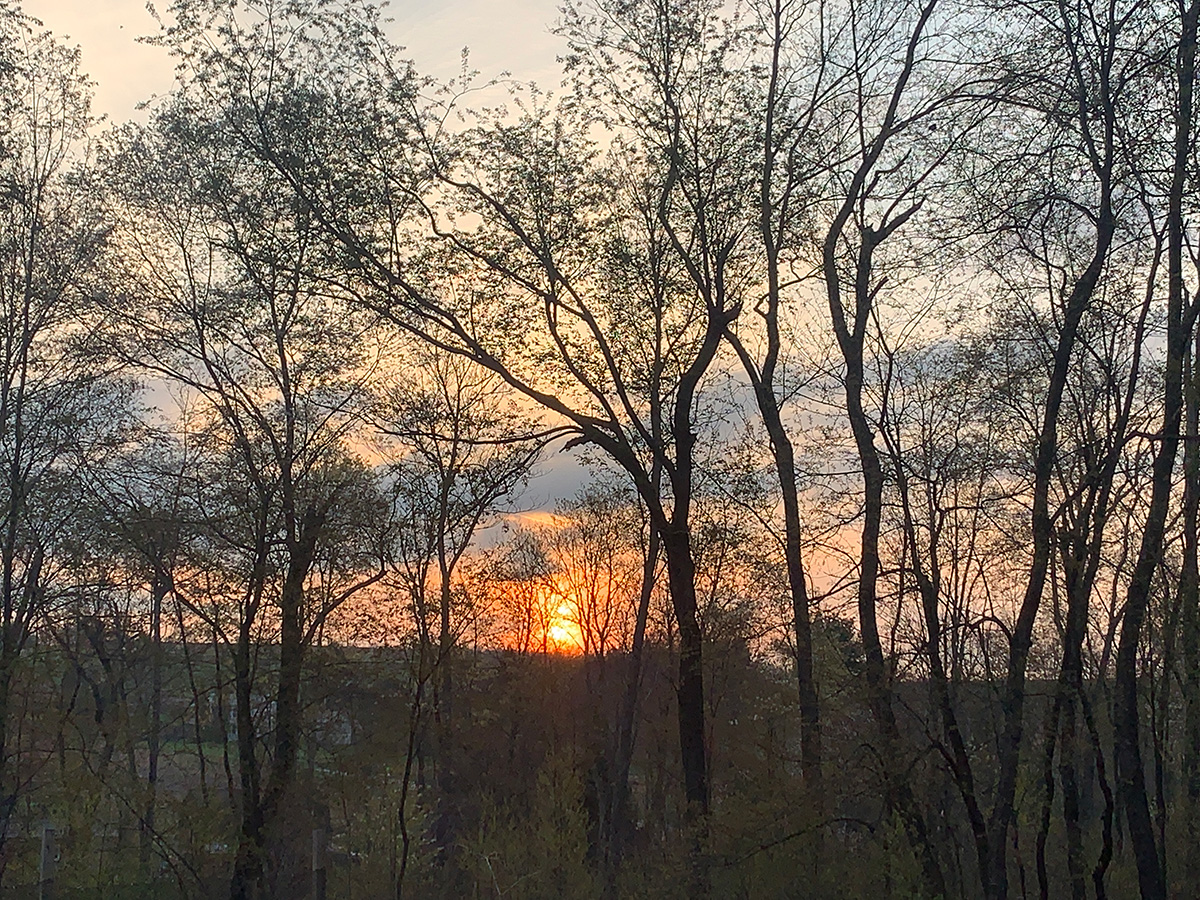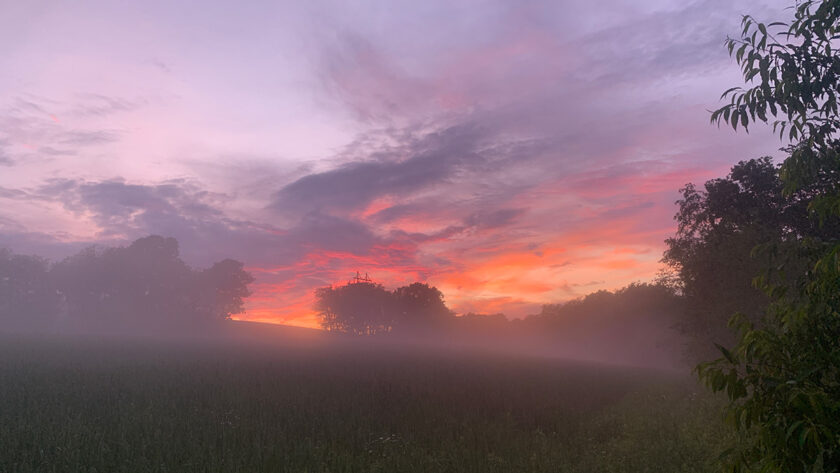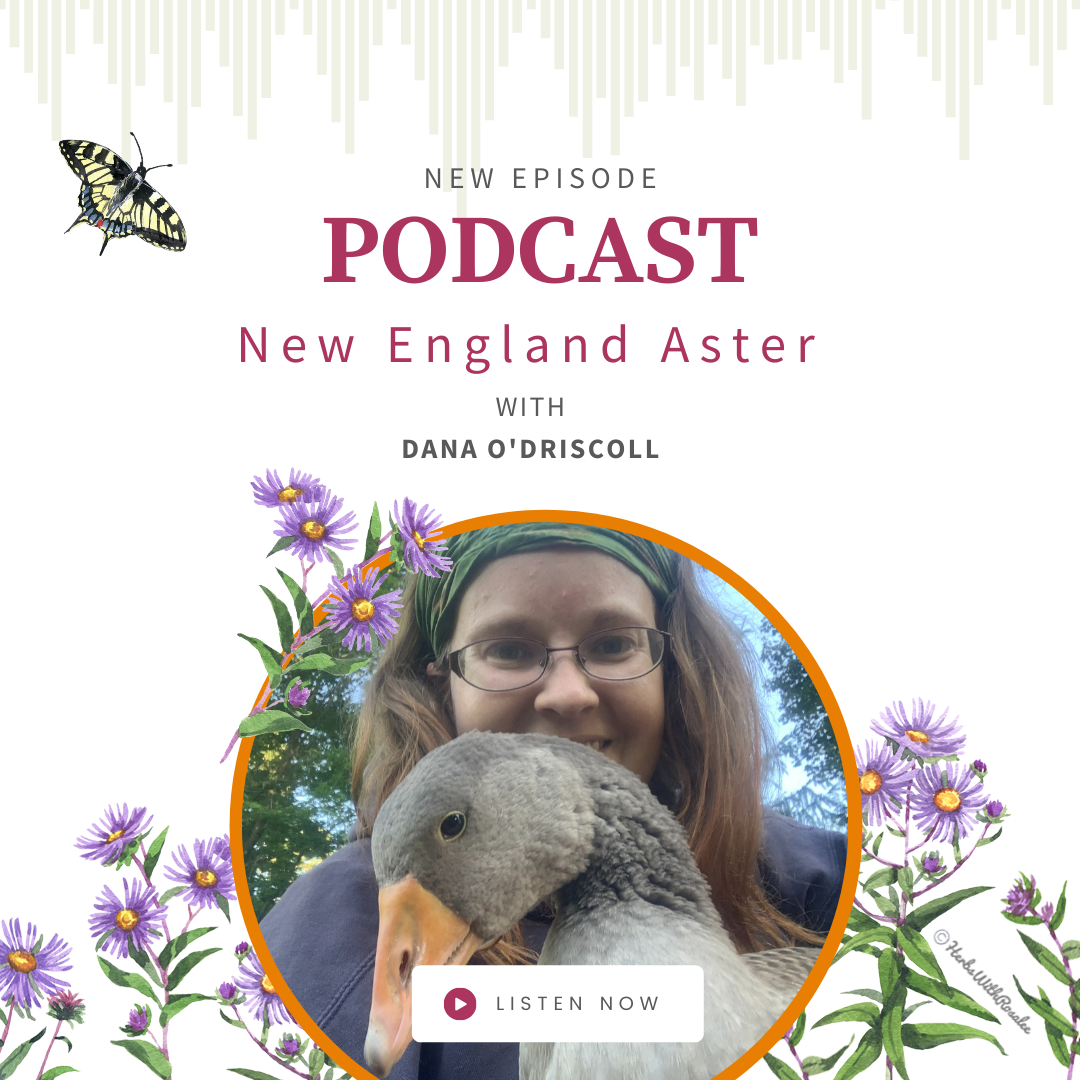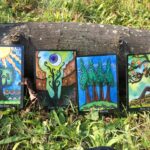As the light grows dim this time of year, as the days grow short, many people find this particular season a difficult one. Without the light, our thoughts can spiral into the darkness, our spirits long for the warmer days. The cold and dark are barely here, and there is so much winter ahead. Just this week, I had three separate conversations with friends about this exact issue: it is a hard time of year, particularly the time between Samhain and Yule, when we know there is much more darkness to come. It is a hard time this year, in particular, when so many of us are beyond stressed and burned out due to the unfolding events of the last two years. It also was a strange year, in that we had temperatures that stayed well above freezing, which kept the leaves green–and suddenly temperatures that plunged very deep below freezing, which dropped all of the leaves in about two days. I realized that there might be some benefit in writing about this time–not so much what is problematic but instead, how we might navigate it from a nature spirituality perspective.

I think that this time is one of the hardest of the year for many people. We know that the cold and dark are on their way. We see the death across the landscape as the bitter cold comes into the land. It’s hard to have a flush, abundant garden one day and the next, find most of your plants have died. This time of year forces us to come face to face with both darkness and death in ways that it is rare during the rest of the year. And the more time we spend on the landscape, the more that this issue stares us in the face. Here in Pennsylvania, it is also complicated by the end of Daylight Savings time, meaning that by the time you leave work, the sun has already set–and there are many days when you do not see the sun at all.
So, what is a druid to do? I have developed a few strategies over the years that have helped myself and others, which I’ll share in the rest of this post!
Embracing the Season and Spiritual Activities

The first strategy is to embrace and honor this time for what it is–accept the cold, the frosts, and the death upon the landscape. I have found that the more I fight against something, the harder it becomes to accept. But, the more that I seek the good and the joy in it, the more enjoyable it becomes.
For this time of year, I have worked hard to find activities that I really love for the late fall and early winter. I have worked to develop a set of rituals and seasonal activities that bring me joy, that I can look forward to, and that sing to my spirit. The whole idea here is that it’s not just about saying “oh, the darkness and cold are here” but really creating intentional activities that make the most of these cold and dark times. Your intentional activities may end up looking very different than mine–but I share these for a model of what you could do. The more things that you have to look forward to and that you enjoy, the better this time of year becomes.
Gardening, Homesteading, and Harvest: Cycles and Looking Forward
If you do wild food foraging, or if you have a garden or homestead, there are a whole host of activities that come with this season–and you can embrace them, make them meaningful, and really look forward to them every year.
For those that do wild food foraging and live in a temperate climate, this is a perfect time to find the last of the nut harvests and spend time processing those nuts. For example, one of my favorite of these is harvesting and processing acorns into acorn flour, which can be used to craft all kinds of sacred bread, cakes, and other delicious ingredients. Acorn flour is a serious endeavor but it is just so worth it! Other nuts in my bioregion are hickories, chestnuts, and hazelnuts–each with their own unique sacredness. This is flour that you can store in the freezer and pull out for sacred activity year-round.
The second activity that I really look forward to this time of year is putting my garden beds to rest. I have worked hard to develop a series of rituals surrounding the end of the growing season: how to work with the annuals that have perished due to the frosts and freezes (saving their seeds, composting them, honoring their journey); bringing in the last harvests of the year, and also clearing the beds for next season. I call this “putting the garden to bed” and it has become an important part of my homesteading activities each year–full of ceremony and honor (I can blog about this if anyone is interested!). I feel like in doing these, I have a good closure to our season and the garden is a blank canvas for planning and planting in the future.

At Samhain, we also burn our Butzemann, which allows us to have full closure for the growing season. The Butzemann is part of the Pennsylvania Dutch tradition, and it is a kind of magical scarecrow that guards the home for the whole light half of the year. At Samhain, it is released through ritual burning, marking the end of the growing season. But like many of the other activities here–it’s not just a closure moment. You also start thinking about your next Butzemann, which you construct at Imbolc. Right now, I have some amazing gourds and dried plants that I am letting sit over winter–I have big plans for these for Imbolc and for next season’s Butzemann.
What you can see from these three examples is that while they are all rooted in the moment of this time–in the growing darkness and cold–they are also rooted in the cycle and hope for the future. The nut harvest and other foraged foods can be brought through the winter and enjoyed in the future. The garden beds being put to rest allow for you to be ready to plant in the spring. The Butzemann is burned, but the materials are started to be gathered for a new one, again, already getting you thinking of that cycle of the year and the promise of spring to come.
The Golden Hour and the Flame
Light and embracing the waning light is an important part of finding balance during this time of year. Because there is so much less light, you begin to pay attention to how to bring it, embrace it, and honor the light. When there is an abundance of light in the summer months, these activities seem less central–but as winter sets in and the days grow so short, finding ways of bringing in the light is critical for balance and peace. Thus, in the time of darkness and cold is to shift your emphasis from the waning sun to the inner and outer flames–through a physical embracing of the between times of light and fires.

One practice that everyone can do is to embrace the “golden hour”. The golden hour happens twice a day–at dawn and at dusk. This is a period of time about 10-20 minutes before the sun comes up when the light changes–either from bright daylight to this golden hue or from darkness to a golden hue. It doesn’t last for too long, but if you go outside during this time, you experience a very magical moment. It happens just after the really spectacular parts of the sunrise in the morning–the light evens out and then you are awash in a golden light. It is particularly powerful when the leaves have changed on the trees–the whole landscape is just aglow in golden light. In the dark half of the year, the golden hour becomes quite accessible–it is easy to be awake both at dusk and dawn, and thus, you can make it a point to embrace the golden hour on the landscape. I find the golden hour to be good bookends for the day–watching the sunrise and sunset. When we are in high summer, these are harder times to access (particularly those in the early morning) and so, it is really in the winter that you can get to experience this lovely time. For me, I like to go out to my druid’s anchor spot and just sit and observe the land waking up or the land going to bed.
The second is to bring fire into your life in any way you can. This might mean bringing in candles and candlelight living–take one day a week to use candlelight rather than electric light and see the difference in your own happiness and stability. This might mean making some candles or olive oil burners for the coming season. Or, this might mean embracing fires in your home. For example, for us, we move from outdoor cooking and having regular outdoor fires to bringing our fires indoors. This includes a whole host of seasonal activities including preparing the hearth, bringing in the wood and lighting the first fires of the season. We have two wood burners in the house–a stove in the basement and an open hearth for cooking and joy on the first floor. Creating fires often and spending a lot of time with these fires can really help!
Whatever way you can, embrace these times of twilight, of limited light, and allow yourself to slow down into the rhythm in the dark half of the year.
Conclusion
I hope that these strategies and activities are helpful to you as we move into this time of deep darkness. Part of the reason I do so much at this time of year is that I do find this time of year–particularly here in Pennsylvania after Daylight Savings Time ends–really challenging. It used to be one of my least favorite times of the year, a time of year that I dreaded. After working so hard to find rituals and seasonal activities that allowed me to embrace it, it is now a time of year that I always look forward to. I wish you blessings in the coming darkness!.
PS: I have recently appeared on Rosalee De La Floret’s “Herbs with Rosalee” Podcast. Please feel free to check it out below! (Or here’s the link directly: https://youtu.be/RvjQgOMxA9E)





Reblogged this on Paths I Walk.
Very nice email. Thank you
On Sun, Nov 14, 2021, 6:30 AM The Druid’s Garden wrote:
> Dana posted: ” As the light grows dim this time of year, as the days grow > short, many people find this particular season a difficult one. Without > the light, our thoughts can spiral into the darkness, our spirits long for > the warmer days. The cold and dark are bare” >
You are welcome :).
Thanks for your wonderful suggestions for adapting to and embracing the darker seasons. I have a difficult time with fatigue. Yes, I notice the golden hour…it is a lovely time. Thanks for your emails. Deborah💚🌲🌳🐶🎃
On Sun, Nov 14, 2021, 8:32 AM The Druid’s Garden Dana posted: ” As the light grows dim this time of year, as the days grow > short, many people find this particular season a difficult one. Without > the light, our thoughts can spiral into the darkness, our spirits long for > the warmer days. The cold and dark are bare” >
Hi Deborah, yeah, I do think there’s a lot of fatigue around this time of year–its the busyness we have here in the US around the holidays, where everything seems to speed up, just as we should be slowing down and embracing nature’s time. At least, that’s my theory on it!
wonderfulxxxxx
Thank you! 🙂
I’d love to hear more about your ritual for putting the garden to bed! Thanks for sharing your path.
Stay tuned for next week 🙂
I loved the podcast Herbs with Rosalee. You sharing your knowledge of plants and talking about the dimensions of plants is wonderful!
I also wanted to mention that I am one who loves this time of year and find the beauty in nature just breathtaking. We live in upstate New York and have had a wonderful fall. I also get excited as we move through this time of darkness but also coziness, with hot teas, long conversations by the fire, and more reading time! I find the approaching winter solstice brings a sense of peace and also that our journey has led us to the shortest days of the year and at the same time turning a corner as we begin the journey back to longer days and the awakening of the earth. So much to celebrate!
Shari
Hi Sharicharron,
There certainly is so much to celebrate in the dark months of the year. We have our first snowstorm today and have the fireplaces blazing, and it feels good to be alive.